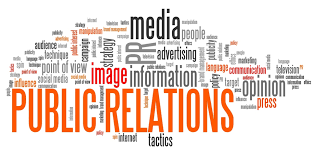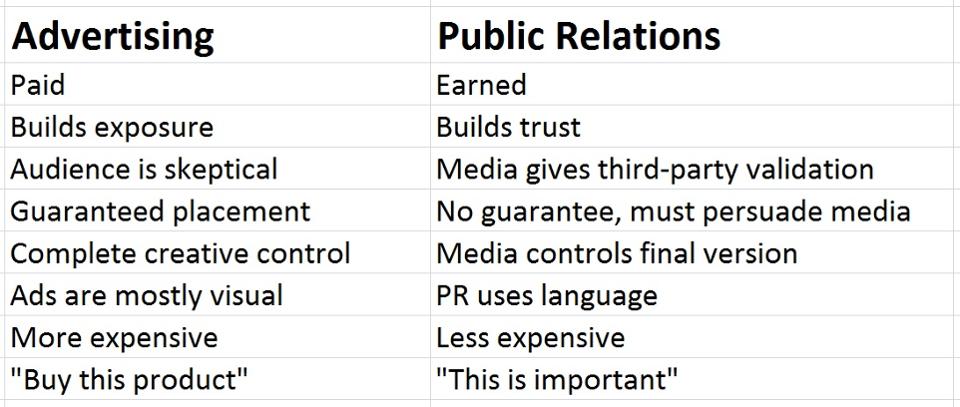
So, what is public relations (PR) anyway?
We mention it as a tool in the bag of our marketing tricks. But, oftentimes, PR is this ambiguous thing that most businesses agree they need. Owners have a vague idea of what it should be, but no clear parameters of what it actually means.
Wikipedia sums public relations up rather nicely in this explanation…
“… The practice of managing the spread of information between an individual or an organization and the public. PR may include an organization or individual gaining exposure to their audiences using topics of public interest and news items that do not require direct payment. The aim of public relations by a company often is to persuade the public, investors, partners, employees, and other stakeholders to maintain a certain point of view about it, its leadership, products, or of political decisions. Common activities include speaking at conferences, winning industry awards, working with the press, and employee communication.”
Forbes made a great point in this article, stating, “PR agencies and advertising agencies share the same goals: promoting clients and making them seem as successful, honest, important, exciting or relevant as possible.” The difference is while you can buy public relations services, you cannot buy public relations. For example, while advertising consists of buying paid ads, PR involves working with media influencers to cover your product, story, brand, which is free press, and oftentimes more valuable than any ad space you can buy.
Public Relations consist of the following:
- Persuasion
- Information
- Communication
- Third-party validation
- Public opinion
- Public policy
- Promotion to drive sales, revenues or donations.
And the Public Relations Society of America (PRSA) defines the management of the functions as:
- “Anticipating, analyzing and interpreting public opinion, attitudes and issues that might impact, for good or ill, the operations and plans of the organization.
- Counseling management at all levels in the organization with regard to policy decisions, courses of action and communication, taking into account their public ramifications and the organization’s social or citizenship responsibilities.
- Researching, conducting and evaluating, on a continuing basis, programs of action and communication to achieve the informed public understanding necessary to the success of an organization’s aims. These may include marketing; financial; fund raising; employee, community or government relations; and other programs.
- Planning and implementing the organization’s efforts to influence or change public policy.
Traditional PR of days gone by focused more on media relationships.
This meant working with media influencers to receive coverage in newspapers, trade journals (often through submissions of press releases or media alerts), or any other credible publication where coverage could persuade your target audience to feel a certain way about your business or product.
Today’s public relations has evolved to include more ‘engagements’ and a broadening consistency of ‘relationship building’. In fact, the evolution of PR evoked PRSA to review the concept of PR and issue the following as a means to redefine the role…
“Public relations is a strategic communication process that builds mutually beneficial relationships between organizations and their publics.”
Modern public relations has evolved to where public relations professionals are wearing a digital hat. We work to solidify relationships, build links, and boisture online credibility and search engine optimization (SEO). We work with social media influencers, building relationships, sharing newsworthy information, in hopes of having those influencers share that information (this would be a great example of third-party validation).
Below are some examples PR professionals use:
- Write and distribute press releases
- Speech writing
- Write pitches (less formal than press releases) about a firm and send them directly to journalists
- Create and execute special events designed for public outreach and media relations
- Conduct market research on the firm or the firm’s messaging
- Expansion of business contacts via personal networking or attendance and sponsoring at events
- Copywriting and blogging for the web (internal or external sites)
- Crisis public relations strategies
- Social media promotions and responses to negative opinions online

As PR professionals, our jobs are to shape images and keep the lines of communication open, honest, and transparent between those we represent, and the public and stakeholders they have a vestment in. A good agency or PR practitioner can analyze an organization, find the positive messages and translate those messages into positive media stories. When the news is bad, an agency can formulate the best response and mitigate the damage. Usually, you will want to hire someone who isn’t an employee so that person can give you honest, objective, and outside view about the subject at hand.
Once again, Forbes summed it up nicely in an article stating:
“Very few stories make the front page of the New York Times, but with a media atmosphere that includes blogs, websites, TV shows, magazines and other media that evolves every day, a good PR agency will help clients increase their visibility via increased recognition on as many respected editorial platforms as possible. Long term, public relations can be an investment in the brand and the visibility of a firm or individual that results in increased recognition and reputation.”
Hopefully, this provides an overview of what exactly public relations is and how it might be useful to your business. PR practitioners are there to guide you in being a good community partner. PR reaches your target audience in an organic way that invokes a spirit of good nature.
For more information on Public Relations in today’s’ digital age, visit PRSA’s article, “Ready, Set, Reset: A Refresher on PR Basics in the Digital Age” for more basics in today’s public relations strategies.



